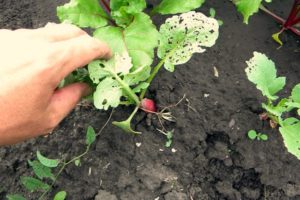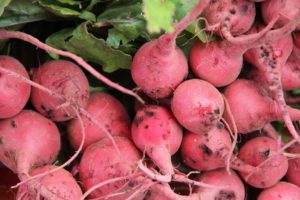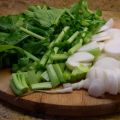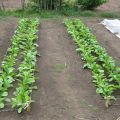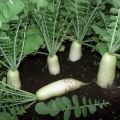Description of the Daikon Dubinushka variety, features of cultivation and care
One of the varieties of the Japanese radish, the daikon Dubinushka, was bred by specialists in the selection and seed production of vegetable crops at the All-Russian Research Institute at the end of the last century. The characteristics of the garden culture are based on the qualities inherent in the representatives of the Cruciferous family.
Daikon from Japanese botanists replaced the Russian radish, which has a pungent taste. In the Pacific Islands, the vegetable is popular due to its beneficial qualities. And the delicate taste of daikon allows it to be consumed fresh and in large quantities.
Description of the variety
Features of Daikon Dubinushka in:
- dissected leaves of a light green shade, slightly pubescent, oval-elongated;
- semi-raised outlet;
- root crops of a cylindrical shape, pointed downwards, 30-40 centimeters long;
- juicy white pulp of the fruit.
The Dubinushka variety belongs to the mid-season species, ripening in 65–70 days from the day of emergence. The size of the radish fruit is large, weighing from 600 grams to 2.5 kilograms, and the pulp is sweetish and with a minimum amount of pungent substances. When consumed, daikon is pleasantly refreshing, so you can make delicious salads from it. The root crop retains its useful qualities well during the winter. You can eat daikon Dubinushka until the next harvest.

Growing
Daikon Dubinushka is cultivated both in early spring and autumn. In the northern regions, you can cultivate a crop under film shelters. Although the radish grows well at low temperatures, it is not colder than 10 degrees with a plus sign. Prolonged cold weather will stop the growth of the daikon and the vegetable will not die. The harvests of juicy root crops will not please summer residents if the summer is cold and with heavy rains.
The Dubinushka variety is cultivated in the open field, since the daikon will have time to fully ripen before the onset of cold weather.
Start planting daikon seeds from mid-April to early May. Seedlings are planted earlier at the age of 30 days, when 3 or 4 true leaves have formed.
It is not recommended to plant the daikon later, otherwise the plant will go to the arrow.
Preparatory measures for planting consist of warming up the seeds in hot water at a temperature of 50 degrees. Then the seed is hardened in the refrigerator for 24 hours. The seeds can be disinfected in a 1% solution of potassium permanganate by lowering the seeds for 20-30 minutes.
A plot for a vegetable is chosen with a loose and nutritious soil, neutral acidity. It is better if the site was previously occupied by potatoes, carrots, zucchini and tomatoes. But after other Cruciferous, daikon is not planted.Many pests, their larvae, pathogenic microorganisms remain in the soil and will not allow the full development of a vegetable crop.
The spring planting of the daikon requires digging the site in the fall. Before plowing, 1–2 kilograms of humus, 40 grams of superphosphate and 20 grams of magnesium sulfate are applied per square meter. Accordingly, pre-winter sowing requires soil preparation in spring.
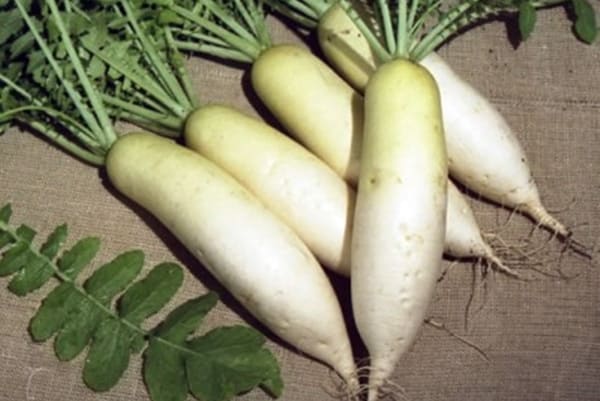
For the cylindrical type of radish Dubinushka, a planting pattern of 30x60 centimeters is chosen. It is better to put 2 grains in each hole, sealed to a depth of 2 centimeters. To make seedlings appear faster, the beds are moistened before planting. After sowing, they also spray the soil with water, mulch with straw, peat or humus. When the weather is cold, you can cover the beds with foil, removing it for a day for airing.
For the preparation of seedlings, 2 seeds are placed in peat pots or peat tablets. The containers with crops are covered with glass or foil, creating greenhouse conditions. After the appearance of the Sents, after 5–7 days, the shelter is removed from the containers.
Seedlings are transplanted into well-heated soil.
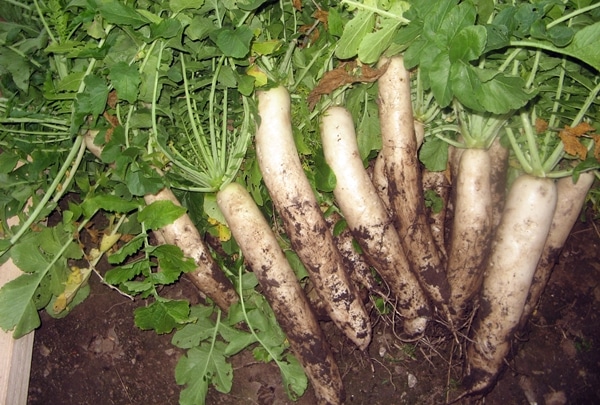
Care features
Daikon is unpretentious, but it needs a lot of moisture, since the climate in the homeland of the vegetable is humid. A gardener, when growing a crop, should be treated with special attention to watering. It should be regular and abundant. But turning the garden into a swamp is not worth it. Overdrying the soil, the daikon will survive, but will go into the arrow, and its skin will become rough, tough in taste. During hot summers, the fruits may crack.
Loosening the soil weekly after heavy rains and irrigation will allow the soil to become air-permeable.
In order not to worry about the constant moistening of the soil in the garden bed with radish, it is necessary to mulch the vegetable plantings with a layer of straw or peat. Aeration is carried out together with weeding, so weeds often become a source of diseases of vegetable crops.

Daikon of the Dubinushka variety needs feeding when the soil is depleted and it does not contain the necessary elements important for the development of the plant. Organic and mineral complexes consist of mullein, diluted in a 1: 5 ratio, potassium sulfate - 4 grams per bucket of water. Combine top dressing with watering. It is useful to add nitrophosphate to the soil by diluting 2 tablespoons in 10 liters of water. For the season, it is enough to feed the mid-season daikon variety twice.
Thickened plantings of the daikon Dubinushka are undesirable. Root crops will not have enough space for a full-fledged growing season, and the plant will shoot. To avoid an unpleasant situation, in phase 2 of these leaves, the radish is thinned. Usually weak, deformed and damaged stems are removed.
It is advised to huddle the Dubinushka variety, since part of the root crop protrudes above the ground. In order for the cylindrical fruits to be less pushed upward from the soil, it is necessary to loosen the bed before planting the seeds to a depth of 30, and preferably 50 centimeters.
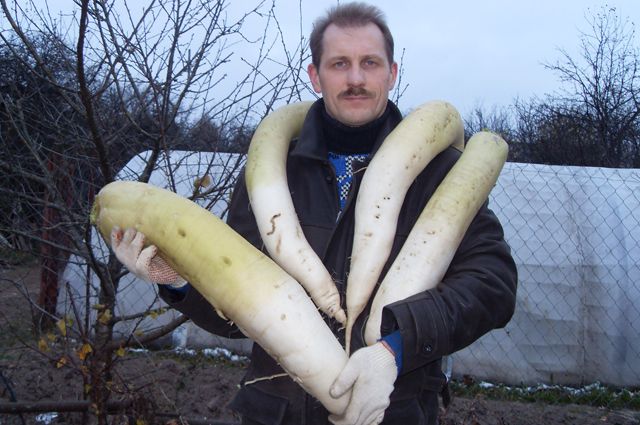
Advantages and disadvantages
Vegetable growers highlight the positive characteristics of a garden crop:
- The juicy, snow-white pulp of the fruit tastes good and is good for human health. Those who suffer from liver and kidney dysfunction consume sweet radish. The use of daikon in various dishes enhances appetite, stimulates the mucous membrane of the digestive tract.
- The productivity of the daikon Dubinushka is high. From 1 square meter, 5 to 7 kilograms of root crops are harvested.
- The vegetable variety is resistant to bacterial infection.
- The harvested roots retain their beneficial properties for a long time, subject to the rules of harvesting and laying in cellars for the winter.
- The Japanese radish variety Dubinushka ripens quickly, and at the end of July you can enjoy juicy fruits.
Among the disadvantages of daikon, susceptibility to fungal infection is noted when the rules of crop rotation are not followed and during periods of wet, cold summers.
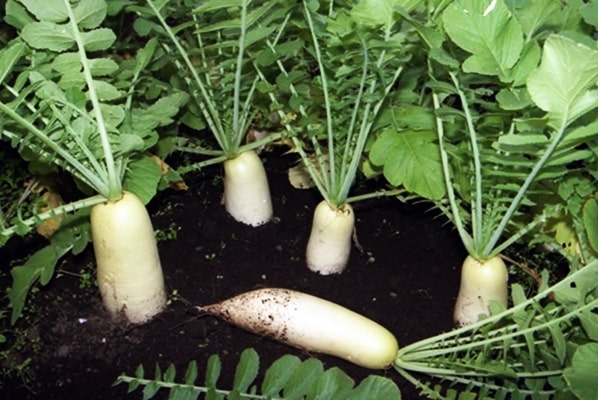
Pests and diseases
Like all representatives of the Cruciferous daikon, the Dubinushka variety is susceptible to black leg fungus. The description of the symptoms of the disease includes a darkening of the plant stem, its thinning and curvature. If measures are not taken, the plant will die. The prevention of the disease is the correct crop rotation of the vegetable crop, the placement of plants at a distance of 30 centimeters. Before planting, daikon seeds should be warmed up in hot water followed by cooling in cold water using gauze bags. When growing daikon through seedlings, they monitor its development, destroying sick and weak plants in time.
With phoma at the initial stage, the stem also turns black at the bottom, but then the leaves are covered with light brown spots and black dots. The root crop does not develop, but dries up, and the plant dies.
Of the pests of Japanese radish, one can distinguish the cabbage fly, the larvae of which destroy the stems and root of the daikon Dubinushka, biting into them. Caterpillars of the cabbage scoop overwinter in the soil. And in spring a small butterfly with brown-gray wings flies out of the pupae. The scoop lays eggs on the underside of the radish leaves. Then the caterpillars that emerged from them feed on the pulp of a radish leaf, eventually moving on to fruits.

You can get rid of pests by treating the daikon with a solution of tobacco dust, dusting the lower part of the stem with wood ash and red pepper. Spraying with infusion of onion peel helps to get rid of parasites. In case of massive damage to the plantings of Japanese radish, Dubinushka uses insecticidal preparations: Aktofit and Lepidotsid.
Harvesting and storage
Root crops that have matured in 2 months begin to be harvested in dry, sunny weather. Daikon is easily pulled out of the ground if the soil is loose. In dense soils, it is necessary to dig the beds with a pitchfork. The pulled-out roots are left on the ground for drying. Only dry fruits can be stored. Wooden boxes are suitable for this, where the radish is put. The container is placed in a room with an air temperature of 3-4 degrees Celsius and a humidity of 75-80 percent. There must be ventilation in the basement or cellar. During the winter, they control the condition of the fruits, remove the damaged ones. With proper storage of the daikon Dubinushka, the harvest from even one garden bed will be enough for a family for the whole winter to prepare vitamin salads.
